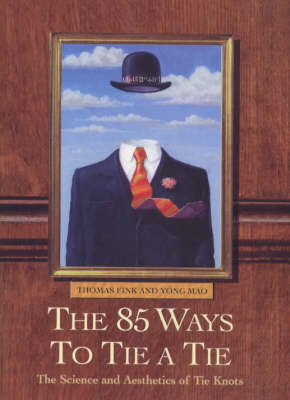
The 85 Ways to Tie a Tie
The Science and Aesthetics of Tie Knots
Seiten
1999
Fourth Estate Ltd (Verlag)
978-1-84115-249-3 (ISBN)
Fourth Estate Ltd (Verlag)
978-1-84115-249-3 (ISBN)
- Titel ist leider vergriffen;
keine Neuauflage - Artikel merken
Paul Smith stylishness collides with Einsteinian precision when, bored with waiting for the next sartorial breakthrough in male fashion, two physicists prove that there are not just four ways to tie a tie, but a further 81. Tie Knots unravels the history of ties, the story of the discovery of the new knots and some very elegant mathematics in action.
If Einstein had been left alone in Tie Rack for long enough perhaps he would have worked it out : why do people tie their ties in only 4 ways? And how many other possibilites are there? Two Cambridge University physicists, research fellows working from the Cavendish laboratories, have discovered via a recherche branch of mathematics – knot theory – that although only four knots are traditionally used in tying neck ties another 81 exist. This is the story of their discovery, of the history of neck ties and of the equations that express whether a tie is handsome or not. Of the 81 new knots, 6 are practical and elegant. We now have somewhere else to go after the Pratt, the Four-in-Hand, the Full and Half Windsor. Sartorial stylishness is wrapped effortlessly around popular mathematics. A concept developed to describe the movement of gas molecules – the notion of persistent walks around a triangular lattice – also describes the options for tie tying. Pure maths becomes pure fashion in a delightfully designed little package from Fourth Estate.
If Einstein had been left alone in Tie Rack for long enough perhaps he would have worked it out : why do people tie their ties in only 4 ways? And how many other possibilites are there? Two Cambridge University physicists, research fellows working from the Cavendish laboratories, have discovered via a recherche branch of mathematics – knot theory – that although only four knots are traditionally used in tying neck ties another 81 exist. This is the story of their discovery, of the history of neck ties and of the equations that express whether a tie is handsome or not. Of the 81 new knots, 6 are practical and elegant. We now have somewhere else to go after the Pratt, the Four-in-Hand, the Full and Half Windsor. Sartorial stylishness is wrapped effortlessly around popular mathematics. A concept developed to describe the movement of gas molecules – the notion of persistent walks around a triangular lattice – also describes the options for tie tying. Pure maths becomes pure fashion in a delightfully designed little package from Fourth Estate.
Dr Thomas Fink (Half Windsor) is a research fellow in the Department of Physics who usually works on protein folding optimisation theory. Dr Yong Mao (New Variant 7,2) is a research fellow at the Department of Physics who usually works on polymers and colloids. They both wear ties.
| Erscheint lt. Verlag | 4.11.1999 |
|---|---|
| Zusatzinfo | (8pp col + integ b/w) |
| Verlagsort | London |
| Sprache | englisch |
| Maße | 132 x 184 mm |
| Gewicht | 246 g |
| Themenwelt | Kunst / Musik / Theater ► Design / Innenarchitektur / Mode |
| Sachbuch/Ratgeber ► Natur / Technik | |
| Mathematik / Informatik ► Mathematik ► Allgemeines / Lexika | |
| Mathematik / Informatik ► Mathematik ► Mathematische Spiele und Unterhaltung | |
| Sozialwissenschaften | |
| ISBN-10 | 1-84115-249-8 / 1841152498 |
| ISBN-13 | 978-1-84115-249-3 / 9781841152493 |
| Zustand | Neuware |
| Haben Sie eine Frage zum Produkt? |
Mehr entdecken
aus dem Bereich
aus dem Bereich
Buch | Hardcover (2012)
Westermann Schulbuchverlag
34,95 €
Schulbuch Klassen 7/8 (G9)
Buch | Hardcover (2015)
Klett (Verlag)
30,50 €
Buch | Softcover (2004)
Cornelsen Verlag
25,25 €


